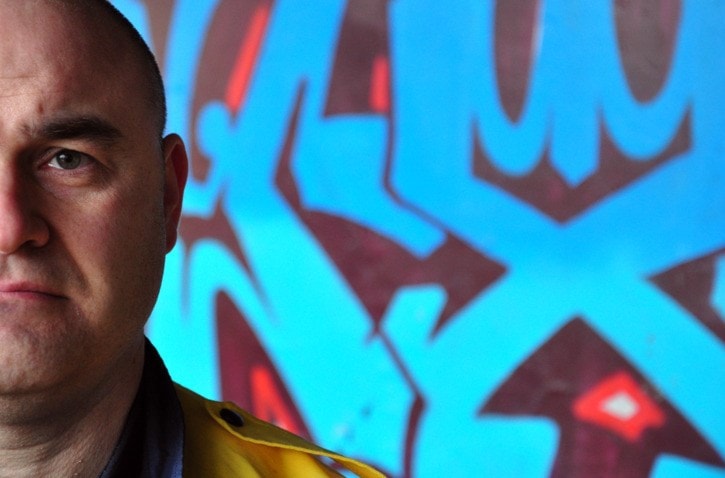City bylaw officer puts pressure on graffiti taggers
To Phil Williams, graffiti tags might as well be photo ID.
Under the Six Mile bridge, he sees evidence of one tagger who is under investigation, and a spray-painted mark of another young man well known to Victoria police. A third larger piece has the signature of a graffiti artist who Williams knows moved to Saskatchewan.
“I see familiar tags all the time,” said Williams, a Colwood bylaw officer. “This place is out of my jurisdiction, but it’s great to gather intelligence.”
While technically in View Royal, Williams photographs new graffiti under the bridge for his growing database of tags, built up over the last four months. He’s a man on a mission to quash graffiti and tagging in Colwood.
Colwood launched a concerted anti-graffiti program in October in the wake of extensive tagging on signs and buildings throughout the community last year. The City hired Williams, an anti-graffiti guru and former Langford bylaw officer who helped that city build unprecedented civil lawsuits against two graffiti vandals.
In Colwood to date, Williams has identified seven taggers, three of whom have painted over 56 tags as part of community service. All are young men, either in their teens or early 20s.
He has photographed and cataloged 376 tags, the majority of which are now painted over. Two taggers are paying $571 to public works for cleanup costs, and bylaw officers have issued 12 municipal tickets for vandalism. Parents of one tagger even surrendered 68 cans of spray paint.
“The program is working and we’ve made huge strides,” said Colwood bylaw enforcement manager Kevin Atkinson. “We’ve picked the right person to do the job, and the city is looking better for it.”
Colwood pays Williams' part-time salary, but the majority of the anti-graffiti program is funded through donations from local businesses. Rona gave $460 worth of paint for a community “paint out” in November, and Thriftys, London Drugs and Best Buy have also donated to the cause. The City is working with BC Hydro and Canada Post on graffiti removal funding agreements.
“Corporate citizens have stepped up in a huge way with no questions asked. They ask, ‘how can we help?’,” Atkinson said. “They’re getting value for their money.”
On the ground, Williams often works “undercover” in plain clothes, monitoring common tagging areas, and passing on locations of new tags to City staff. Colwood public works has standing orders to paint over new tags within 24 hours.
“Taggers want to be noticed. If they tag the same spot you have to clean it right away. Persistence pays off,” Williams said.
“Several of the most prolific taggers have been caught, but a new generation is coming up so its important to keep up the momentum.”
The officers think the rate of tagging in the city is falling, but they won’t really know until after the winter. They doubt the city will ever be 100 per cent free of graffiti tags. “It’s not about graffiti elimination," Williams said. "it’s about managing it, keeping it to a minimum."
Some communities have a “freewall” for graffiti artists to paint, but those projects, while admirable, usually promote “bleed out” into surrounding neighbourhoods, the officers say. The skate park in Langford is a prime example.
“There is huge bleed out into (Langford),” Williams said. “There’s many tags on (Belmont) school grounds and local businesses.”
Colwood bylaw officers network with anti-graffiti officers in other municipalities, such as Langford and Victoria, in an effort not to just push the problem into another community. One partnership with West Shore RCMP community policing section could play a key role in future anti-graffiti efforts.
Community policing staff have agreed to input Colwood municipal ticket convictions linked to graffiti into the PRIME database, the primary offender database for police in B.C.
That effort “is in its infancy,” Williams said, but as it grows, police and courts across the region will be able to see municipal tickets issued to taggers, not just the rarer criminal convictions. “If someone gets a ticket for graffiti, now the police are notified,” Williams said. On Colwood’s end, it is bumping up vandalism fines to $500 from $100.
The $20,000 anti-graffiti program is considered a six-month pilot project and Colwood council will need to decide in April if it will be funded again. Last year, the first six months of cleaning up tags cost the City about $10,000.
Williams and Atkinson told the protective services committee that businesses are willing to donate paint and equipment, but without certainty of continuing, it’s difficult to get commitments.
“I’m in a bit of a catch-22,” Williams said. “A lot of donations have come in, and a lot of sponsors are interested, but it’s hard for them to commit if they don’t know if the program will continue or not.”
The driving force behind the anti-graffiti effort is to make the city look clean, polished, and unthreatening. Atkinson said its hard to directly measure the benefits of graffiti abatement, but he argues council and the community are getting their money’s worth.
“There is a lot of intangible things behind this. Graffiti can give the perception an area is not safe, it deters business,” Atkinson said. “The West Shore is a place we want people to live and work, and tagging is a deterrent.”
editor@goldstreamgazette.com
